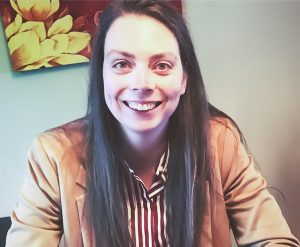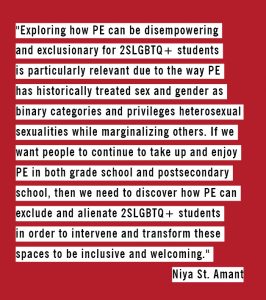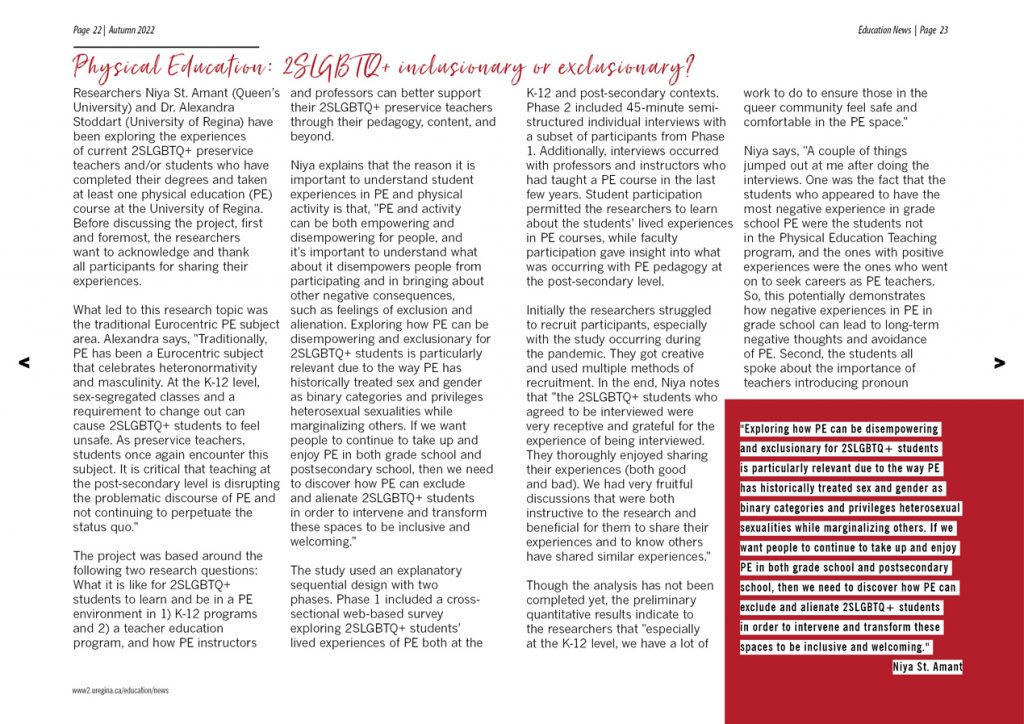

Researchers Niya St. Amant (Queen’s University) and Dr. Alexandra Stoddart (University of Regina) have been exploring the experiences of current 2SLGBTQ+ preservice teachers and/or students who have completed their degrees and taken at least one physical education (PE) course at the University of Regina. Before discussing the project, first and foremost, the researchers want to acknowledge and thank all participants for sharing their experiences.
What led to this research topic was the traditional Eurocentric PE subject area. Alexandra says, “Traditionally, PE has been a Eurocentric subject that celebrates heteronormativity and masculinity. At the K-12 level, sex-segregated classes and a requirement to change out can cause 2SLGBTQ+ students to feel unsafe. As preservice teachers, students once again encounter this subject. It is critical that teaching at the post-secondary level is disrupting the problematic discourse of PE and not continuing to perpetuate the status quo.”
The project was based around the following two research questions: What it is like for 2SLGBTQ+ students to learn and be in a PE environment in 1) K-12 programs and 2) a teacher education program, and how PE instructors and professors can better support their 2SLGBTQ+ preservice teachers through their pedagogy, content, and beyond.
 Niya explains that the reason it is important to understand student experiences in PE and physical activity is that, “PE and activity can be both empowering and disempowering for people, and it’s important to understand what about it disempowers people from participating and in bringing about other negative consequences, such as feelings of exclusion and alienation. Exploring how PE can be disempowering and exclusionary for 2SLGBTQ+ students is particularly relevant due to the way PE has historically treated sex and gender as binary categories and privileges heterosexual sexualities while marginalizing others. If we want people to continue to take up and enjoy PE in both grade school and postsecondary school, then we need to discover how PE can exclude and alienate 2SLGBTQ+ students in order to intervene and transform these spaces to be inclusive and welcoming.”
Niya explains that the reason it is important to understand student experiences in PE and physical activity is that, “PE and activity can be both empowering and disempowering for people, and it’s important to understand what about it disempowers people from participating and in bringing about other negative consequences, such as feelings of exclusion and alienation. Exploring how PE can be disempowering and exclusionary for 2SLGBTQ+ students is particularly relevant due to the way PE has historically treated sex and gender as binary categories and privileges heterosexual sexualities while marginalizing others. If we want people to continue to take up and enjoy PE in both grade school and postsecondary school, then we need to discover how PE can exclude and alienate 2SLGBTQ+ students in order to intervene and transform these spaces to be inclusive and welcoming.”
The study used an explanatory sequential design with two phases. Phase 1 included a cross-sectional web-based survey exploring 2SLGBTQ+ students’ lived experiences of PE both at the K-12 and post-secondary contexts. Phase 2 included 45-minute semi-structured individual interviews with a subset of participants from Phase 1. Additionally, interviews occurred with professors and instructors who had taught a PE course in the last few years. Student participation permitted the researchers to learn about the students’ lived experiences in PE courses, while faculty participation gave insight into what was occurring with PE pedagogy at the post-secondary level.
Initially the researchers struggled to recruit participants, especially with the study occurring during the pandemic. They got creative and used multiple methods of recruitment. In the end, Niya notes that “the 2SLGBTQ+ students who agreed to be interviewed were very receptive and grateful for the experience of being interviewed. They thoroughly enjoyed sharing their experiences (both good and bad). We had very fruitful discussions that were both instructive to the research and beneficial for them to share their experiences and to know others have shared similar experiences.”
Though the analysis has not been completed yet, the preliminary quantitative results indicate to the researchers that “especially at the K-12 level, we have a lot of work to do to ensure those in the queer community feel safe and comfortable in the PE space.”
Niya says, “A couple of things jumped out at me after doing the interviews. One was the fact that the students who appeared to have the most negative experience in grade school PE were the students not in the Physical Education Teaching program, and the ones with positive experiences were the ones who went on to seek careers as PE teachers. So, this potentially demonstrates how negative experiences in PE in grade school can lead to long-term negative thoughts and avoidance of PE. Second, the students all spoke about the importance of teachers introducing pronoun usage to demonstrate an inclusive classroom as one small thing teachers and professors can do to ensure 2SLGBTQ+ students feel welcomed and included in the space. For instance, teachers sharing their pronouns and inviting others to do the same on the first day of class. So, this demonstrates that 2SLGBTQ+ students are seeking more inclusive environments that stretch beyond just the PE environment and to classrooms in general, but are perhaps, most important in the PE environment where 2SLGBTQ+ students have faced particular discrimination and negative experiences.”
The researchers intend to use the findings of this research to help them change the way they do things in PE spaces and to promote and enhance 2SLGBTQ+ inclusion at the University of Regina, specifically in the Faculty of Education and beyond. “It is our responsibility in the Faculty to enact change and not put the onus and burden on students,” says Alexandra.
Funding for this project was acquired through the University of Regina’s Humanities Research Institute 2SLGBTQ+ Equity, Diversity, Inclusivity Research Microgrant.
Follow us on social media